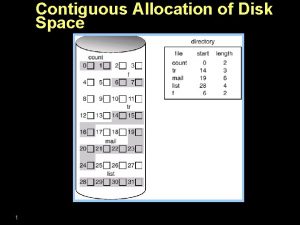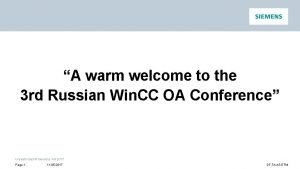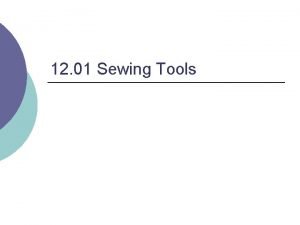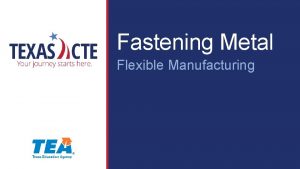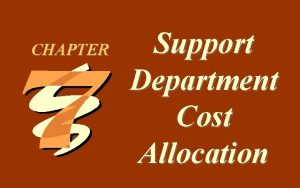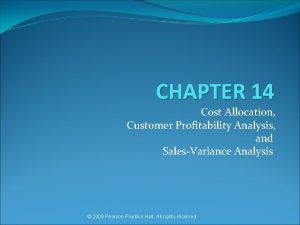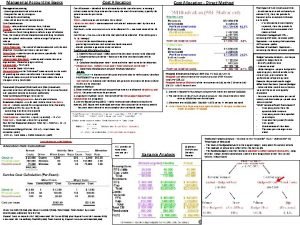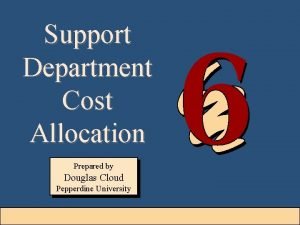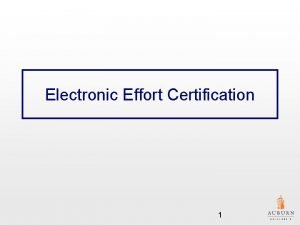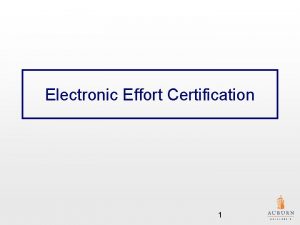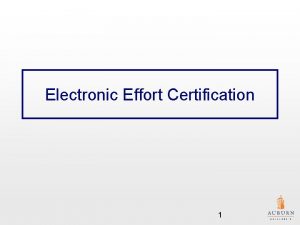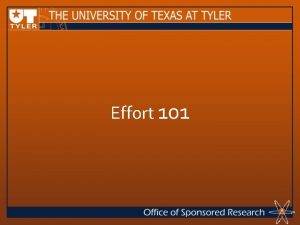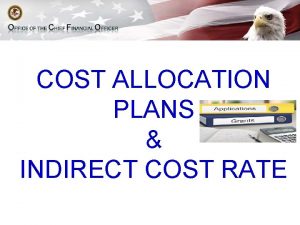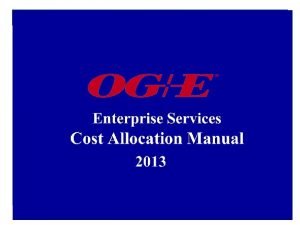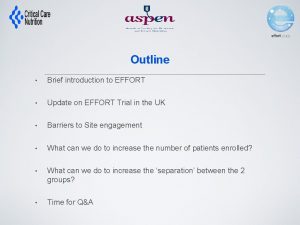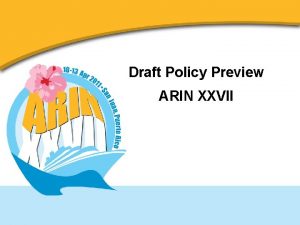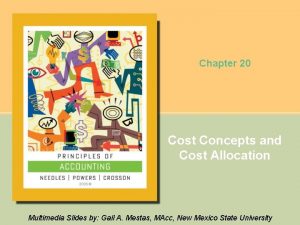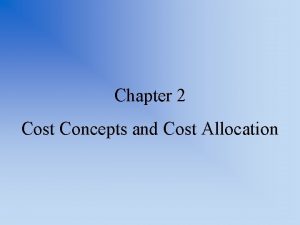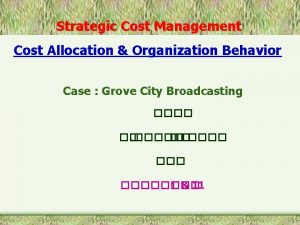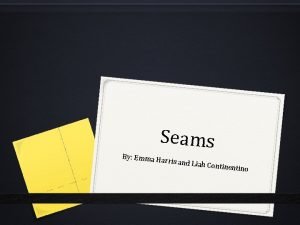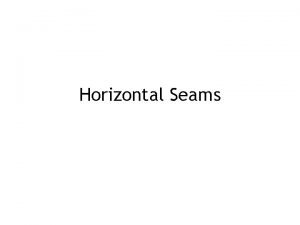DRAFT Update on RSC Seams Cost Allocation Effort







































- Slides: 39

DRAFT Update on RSC Seams Cost Allocation Effort Presented to: SPP Seams Steering Committee Presented by: Johannes Pfeifenberger Delphine Hou September 30, 2011 Copyright © 2011 The Brattle Group, Inc. www. brattle. com Antitrust/Competition Commercial Damages Environmental Litigation and Regulation Forensic Economics Intellectual Property International Arbitration International Trade Product Liability Regulatory Finance and Accounting Risk Management Securities Tax Utility Regulatory Policy and Ratemaking Valuation Electric Power Financial Institutions Natural Gas Petroleum Pharmaceuticals, Medical Devices, and Biotechnology Telecommunications and Media Transportation

Agenda 1. Welcome and Introductions Sam Loudenslager 2. Update from Brattle ♦General Approach Document ♦Sample Projects ♦Project Schedule ♦Discussion by SCATF Hannes Pfeifenberger 3. Comments on SSC White Paper Group 4. Next Steps Group 5. Future Meetings Sam Loudenslager 6. Adjournment Draft 2

Presentation Content Recap and Introduction General Cost Allocation Framework Proposed Additional Candidate Projects Project Schedule Discussion by SCATF Draft 3

Recap The August SPP Seams Steering Committee meeting resulted in the following tasks: ♦ For Brattle consultants – review existing seams cost allocation principles and methodologies and in collaboration with the Seams Cost Allocation Task Force (SCATF); develop a robust framework in which to consider seams cost allocation for SPP and its neighbors. Brattle to present DRAFT today ♦ For SSC members and seams neighbors – provide an example of a potential seams project that may be a good test case for a framework developed by Brattle. Based on responses from AECI, AEP, Entergy, SPP ♦ For all participants – provide feedback on SPP Draft Seams Cost Allocation Principles. Received responses from AECI, Entergy, and Brattle Draft 4

Introduction Development of a seams cost allocation framework: ♦ Brattle consultants took the lead in developing a “generalized” cost allocation framework, which is envisioned as an integral part of the interregional planning process ♦ Brattle consultants drafted a document laying out concept, shared with the SCATF ♦ SCATF provided feedback on the draft memo, which is incorporated and presented in the following slides ♦ This is still a work in progress and we expect there to be considerable discussion amongst, feedback from, and fine-tuning with SPP Seams Steering Committee members Draft 5

Presentation Content Recap and Introduction General Cost Allocation Framework A. General Approach B. Overview – “Interregional Planning and Cost Allocation Agreements” C. IPCAA Details D. Interregional Cost Allocation Proposed Additional Candidate Projects Project Schedule Discussion by SCATF Draft 6

A. General Approach Cost Allocation Framework A cost allocation framework should be robust and flexible enough: ♦ To be applied to all of SPP’s neighbors, which spans both FERC jurisdictional and non-jurisdictional entities; ♦ To be compliant with FERC Order 1000; ♦ To provide enough guidance under uncertainties with some standardization of procedure rather than a case-by-case analysis; and ♦ To allow for learning based on experience. The cost allocation framework should be an integral part of the interregional planning process ♦ For example, bilateral or multilateral Interregional Planning and Cost Allocation Agreements (IPCAAs can be part of or leverage existing JOAs) Seams neighbors would have certain obligations to consider and analyze seams projects (proposed by their neighbor) that, based on preliminary analysis, could benefit both entities Draft 7

A. General Approach (cont’d) Cost Allocation Framework Proposed seams projects should have benefits evaluated that at minimum: ♦ Show that benefits are roughly commensurate with allocated costs ♦ Reflect the benefits and metrics already in considered in each entity’s internal transmission planning process Benefits to each seams neighbor (and metrics used to assess them) do not have to be the same for both entities If agreed to by both seams neighbors, seams projects can be evaluated considering benefits and metrics beyond those used in their internal transmission planning processes (e. g. , ATC increases and estimates of additional wheeling out or through revenues) Draft 8

B. Overview Interregional Planning and Cost Allocation Agreements Proposed elements that would be required of any IPCAA: ♦ Consistency with FERC Order 1000 and interregional planning and cost allocation principles ♦ IPCAAs may be bilateral or multilateral and would include: 1) Commitment to periodic meetings of the seams neighbors; 2) Commitment to the periodic exchange of planning data; 3) The obligation to analyze candidate seams projects proposed by the seams neighbor that meet pre-specified criteria; 4) Specification of evaluation criteria and benefit metrics that each neighbor would use for seams projects; 5) Specification of agreed-to cost-allocation principles and guidelines; and 6) Specification of payment mechanisms that allow for the actual sharing of project investment costs or project revenue requirements. 1)IPCAAs would mostly be bilateral agreements that vary across pairs of seams neighbors to reflect the entities’ own transmission planning and cost allocation processes Draft 9

B. Overview (cont’d) Interregional Planning and Cost Allocation Agreements Scope of benefits and metrics considered in IPCAAs: ♦ Benefits and metrics applied to seams projects by each entity should, at a minimum, reflect the scope of benefits and metrics in the entity’s internal transmission planning process • Will generally differ across seams entities • May be specified for different types of transmission projects (e. g. , reliability, congestion relief, public policy, or a combination) ♦ If supported by both seams neighbors, the seams agreement may also: • Recognize additional benefits not reflected in each entity’s internal transmission planning process such as: ■ ■ ■ Avoided cost of internal projects ATC increases, fewer rejections of transmission service requests, and related increases of wheeling-out and –through revenues Transfer-value adder to adjusted production costs • Be flexible enough to allow neighbors to agree on and recognize additional project-specific benefits even if that type of benefit has not been prespecified in the agreement Draft 10

B. Overview (cont’d) Interregional Planning and Cost Allocation Agreements Specification of Cost Allocation Principles and Guidelines: ♦ Each IPCAA would include general cost allocation principles and guidelines that would relate to benefit metrics • Cost allocation principles lay out the general framework • Guidelines provide examples/illustrations of how cost allocation might be derived for specific types of projects ♦ Cost allocations principles and guidelines would be specific enough so that each seams entity, after conducting its own analysis, might be able to suggest a cost allocation for a proposed seams project as the starting point for further evaluation ♦ As analyses are completed by both neighbors, projects can be reconfigured and cost allocations be adjusted so that the benefits roughly align with costs Pre-specified formulaic project evaluation and cost allocation methodologies may be part of the agreement but are not required ♦ Example: a MISO-PJM formulaic approach for interregional reliability projects ♦ Could be added as experience with certain types of projects is gained Draft 11

C. IPCAA Details Commitments Made in IPCAAs would detail the commitments made by the seams neighbors, including: ♦ Data exchange - Seams neighbors would develop a process to exchange planning data such that each seams entity is able to better assess in its own analyses the impacts of proposed seams projects on its neighbors. • Can leverage existing JOAs and expand to include additional data and assumptions, a process for data exchange (website/FTP site), point of contact, etc. • Possibly evolve into multi-regional coordination (e. g. , TEPPC in WECC) ♦ Commitment to coordinated planning – Establish regular interregional planning meetings (e. g. , twice a year) to discuss updates of planning studies and data, candidate seams projects that may be formally proposed later, analyses performed formally-proposed seams projects, feasible cost allocations, and the status of formally-proposed seams projects within each entity’s internal approval process. • Can leverage existing JOAs and groups (such as the Entergy SPP RTO Regional Planning Process) • Could also create multilateral groups (e. g. , seams-related planning groups in WECC) which meet periodically to coordinate inter-regional planning Draft 12

C. IPCAA Details Commitments Under IPCAAs (cont’d) ♦ Requirement for seams project designation and analysis – Each seams neighbor would be able to propose (e. g. , by a certain date once a year) individual or groups of seams projects that, based on its own preliminary analysis, would potentially provide meaningful benefits to the two neighboring systems ♦ Responsibilities of a seams project proponent – The proponent would need to undertake preliminary analyses to identify benefits to the neighboring system consistent with the evaluation criteria and benefit metrics specified in the IPCAA • Can also propose preliminary cost allocations that are consistent with the specified • • Draft cost allocation principles and guidelines (see below) Analysis may include types of benefits not specified in the IPCAA for informational purposes and possible future consideration Example: SPP proposes a potential seams project between SPP and AECI. SPP will conduct a preliminary analysis which will evaluate benefits for the AECI system focused on reliability and load serving capability improvements. SPP on the other hand, may evaluate its benefits of the project based on economic metrics such as adjusted production costs. For informational purposes, SPP may also quantify adjusted production cost savings for the AECI system. 13

C. IPCAA Details Commitments Under IPCAAs (cont’d) ♦ Responsibilities of a potential seams project neighbor – The IPCAA would commit the seams neighbor to perform its own analysis of a seams project by its proponent entity within a specified time frame that has been agreed to by both parties (e. g. , 6 -12 months). • That analysis would also be consistent with the neighbor’s own transmission planning process and assess the benefits that the proposed project would provide to its own system or to both parties, thereby confirming, refining, or expanding the preliminary analyses by the seams project proponent. Draft 14

C. IPCAA Details Seams Project Qualification Requirements As long as the proposed seams project addresses both seams entities’ transmission needs and offer benefits to both, we propose: ♦ No strict component composition – A “seams project” can be a single line or transmission component or be comprised of several lines and/or components that are logically grouped together ♦ No physical location requirement - May be located wholly within one entity’s footprint or may cross over the seam • Note: Only the latter is defined as an “interregional” project in Order 1000 ♦ No pre-defined threshold limits – No threshold such as voltage class, total cost, and total benefits • Some seams projects may be considered “small” but offer substantial benefits ♦ But proposed seams projects would need to be accompanied by detailed project description and preliminary analyses (see next page) Draft 15

C. IPCAA Details Seams Project Qualification Requirements (cont’d) To “qualify” as a seams project and trigger the commitments made by the neighboring seams entity in the IPCAA, the proponent of a seams project would need to submit: ♦ A formal proposal to its neighbor, including a detailed description of the project ♦ A qualitative discussion of the project’s purpose and benefits to both neighbors • For example, the proposed project may address reliability and market efficiency concerns for one neighbor and generation interconnection and load serving issues for the other ♦ Preliminary screening analyses (e. g. , power flow studies) of the project’s benefits to both entities • Documenting results, assumptions, and data • Present analyses and results consistent (though not necessarily comprehensive in scope) with the planning methods and metrics of each neighbor as specified in the IPCAA ♦ Propose preliminary cost allocation consistent with benefits identified in screening analyses Draft 16

D. Interregional Cost Allocation Issues Addressed in Each IPCAA Interregional cost allocation issues addressed in each IPCAA would be organized along the following categories: ♦ Cost Allocation principles and guidelines - would serve as the overarching framework for the evaluation of seams projects and consequent interregional cost allocation of specific seams projects based on the benefits identified for each seams neighbor ♦ Benefit metrics – at minimum would specify the type of benefits and metrics considered by each entity in its internal transmission planning process ♦ Cost sharing and payment mechanisms – can include financial transfer payments or other arrangement such as cost allocation through ownership shares ♦ Pre-specified formulaic evaluation and cost allocation options – can have the option to include at a later date pre-specified formulaic project evaluation and cost allocation options that could be applied to specific types of projects Draft 17

D. Interregional Cost Allocation Principles and Guidelines The agreement would specify the “general cost allocation principles” that will be applied to seams projects ♦ Must at minimum satisfy FERC Order 1000 principles: • • • Costs must be “at least roughly commensurate” with benefits Those that receive no benefit must not be allocated costs involuntarily Benefit-to-cost ratios, if used, must not exceed 1. 25 No involuntary allocation of costs Transparent cost allocation method and identification of beneficiaries Different cost allocation methods can apply to different types of transmission projects (e. g. , reliability, economic, public policy, existing vs. new) ♦ But can be broader and more detailed than Order 1000 requirements • Examples: UMTDI, Northern Tier • May specify principles that would apply to different types of transmission projects (reliability, economic, public policy, multi-value) Draft 18

D. Interregional Cost Allocation Principles and Guidelines (cont’d) The agreement would also include “cost allocation guidelines” that, possibly with examples, may: ♦ Explain how to develop cost allocation based on specific benefits metrics (e. g. , APC, cost of avoided alternative projects, increased ATC) ♦ Explain how to consider, weigh, and/or combine different types of benefits (e. g. , reliability vs. public policy vs. market efficiency, including increased transfer capability) ♦ Provide guidance on how to consider more qualitative, non-monetary benefits for purpose of cost allocation (e. g. , increased system stability, improved load serving capability, options for future expansion, increased operating flexibility) ♦ How to use physical location and ownership shares as a starting point and mechanism for cost allocation Draft 19

D. Interregional Cost Allocation Benefits Metrics Each agreement would specify the benefits and metrics considered in the evaluation of seams projects. ♦ The benefits and metrics considered by each neighbor should, at a minimum, ♦ ♦ Draft include the benefits and metrics used in each entity’s internal transmission planning process A seams entity would have the option (but not the obligation) to consider all of the benefits and/or adopt metrics of the other seams entity, even if these benefits and metrics are not currently used in the entity’s internal transmission planning process The agreement may specify additional agreed-to benefits that are unique to seams projects (e. g. , increased ATC and wheeling revenues) The agreement would make it clear that entirely different sets of benefits may accrue to the neighbors. For example, a particular project: • May offer mostly congestion relief to one entity but mostly addresses an interconnection need and reliability concern of the other entity • May be an “economic project” for one of the entities but a “reliability project” to the other New types of benefits can be considered on project-specific basis if neighbors agree 20

D. Interregional Cost Allocation Cost Sharing and Payment Mechanisms Each IPCAA would need to identify cost sharing and payment mechanism to allow one neighbor to pay for a portion of the project or its annual revenue requirements. We describe two methodologies: ♦ Financial transfer payments • Could be based simply on cost allocation agreement (e. g. , similar to payments associated with cost sharing within SPP or MISO) ■ This methodology would likely be most effective between organized markets such as SPP and MISO but may be difficult for non-jurisdictional and public power entities which do not or cannot pay for costs of facilities they do not own or do not have contractual rights to • Agreements with non-RTO entities would likely involve additional contractual arrangements, such as the granting of certain rights to the use of the paid-for facilities owned by the seams neighbor. Examples include: Draft ■ Firm use of these transmission facilities, including import or export capability ■ A specified level of usage on a neighbor’s upgraded flowgate(s) 21

D. Interregional Cost Allocation Cost Sharing and Payment Mechanisms ♦ Cost allocation through ownership shares • Full ownership could be assigned to certain segments of a seams project such that the cost of each owned portion is “roughly commensurate” to each seams entity’s quantified (or possibly perceived) benefits ■ ■ Each segment would be constructed, fully owned, and operated by one of the seams neighbor Each entity would recover from its own customers (and consistent with the entity’s existing tariff for within-region cost recovery) the revenue requirements associated with the allocated segments of the seams project • If the project has segments that are clearly within each of the entities’ footprints, the costs associated with these segments may be a logical starting point for a possible cost allocation until a full evaluation of the project is completed by both entities ■ Example: Branson Area Project has 3 legs – two western legs that could be allocated to SPP and one eastern leg that could be allocated to AECI • Initial ownership shares could be adjusted/confirmed based on the final set of analyses to make sure that ownership-based shares of total project costs are consistent with the cost allocation principles (e. g. , roughly commensurate with the distribution of identified benefits) Draft 22

D. Interregional Cost Allocation Cost Sharing and Payment Mechanisms ♦ Cost allocation through ownership shares (cont’d) • Joint ownership could be used where a seams project cannot be divided into fully-owned segments or if a proposed project (or part of a project) is entirely within the service territory of one of the seams entities ■ Ownership shares would reflect the agreed-upon cost allocations which are roughly commensurate with quantified (or perceived) benefits • Co-ownership agreements would specify rights and obligations ■ ■ Each party may be granted a share of firm use of the transmission facilities owned by the other party (e. g. , shares of flowgate capacity) Since ratebase is co-owned, agreement may also need to specify sharing of operating costs Note: Such ownership-based cost allocations (full ownership of individual segments of a larger project and/or joint ownership of individual segments or the entire project) are commonly used in the WECC. This is the case even for projects that are entirely in the control area of only one of the utilities. Utilities would generally obtain scheduling rights in proportion to the ATC provided by the co-owned project. Draft 23

D. Interregional Cost Allocation Pre-specified Formulaic Evaluation & Cost Allocation Options Seams neighbors can pre-specify formulaic project evaluation and cost allocation options that could be applied to specific types of projects: ♦ This is an option between seams entities and may be added to the IPCAAs over time as more experience is gained ♦ Different formulas can be applied to specific project types (e. g. , reliability, economic, public policy, multi-value) ♦ Such fully or partly pre-specified options would be based on (i) specific metrics for the evaluation of seams transmission projects and (ii) a pre-specified cost allocation methodology that formulaically relies on these benefits and metrics. • Entities that already use similar pre-specified metrics (e. g. , use of APC in SPP and • • MISO) would be more likely to adopt this approach Examples: PJM-MISO interregional evaluation and cost allocation process for reliability and economic projects A less formulaic option (e. g. , in an agreement between SPP and AECI) might include a cost allocation in proportion to each entity’s avoided costs of implementing their own alternative solutions to the identified reliability problems Projects that do not “fit” any pre-specified options would be considered under the general cost allocation principles. Draft 24

Recap and Introduction General Cost Allocation Framework Proposed Additional Candidate Projects ♦ Entergy/Cleco/LUS – Acadiana Load Pocket (ALP) Project ♦ SPP/AECI – Proposed Branson Area Project ♦ SPP (AEPW)/Entergy – Proposed Quarry Project (Western Region) ♦ SPP (OGE)/Entergy – Proposed Danville Area EHV Station ♦ SPP (AEPW)/Entergy – Proposed Murfreesboro Project Schedule Discussion by SCATF Draft 25

Sample Projects Examples of Seams Projects to be Used for Evaluation Members of the SPP Seams Steering Committee and representatives of seams neighbors were asked to provide candidate seams projects, including the following information: ♦ Why is the project needed from your company’s perspective? ♦ What do you see as the possible benefits? ♦ If you have existing studies of the project, please provide them. ♦ What are the barriers to the project (why hasn’t it been pursued)? ♦ Are there lower cost projects that be interesting to evaluate? The following candidate seams projects were received: ♦ Entergy/Cleco/LUS – Acadiana Load Pocket (ALP) Project ♦ SPP/AECI – Proposed Branson Area Project ♦ SPP (AEPW)/Entergy – Proposed Quarry Project (Western Entergy Area) ♦ SPP (OGE)/Entergy – Proposed Danville Area EHV Station ♦ SPP (AEPW)/Entergy – Proposed Murfreesboro Draft 26

Sample Projects Examples of Seams Projects to be Used for Evaluation (cont’d) SPP and the SCATF had previously suggested the following candidate seams projects for evaluation: ♦ Branson Area Projects ♦ Nebraska City – Sibley ♦ Turk – Mc. Neil ♦ Dolet Hills – Messick ♦ Lacygne - Mariosa Delta Of these, only the Branson Area Projects have been “seconded” by seams neighbors at this point. Draft 27

Sample Projects Acadiana Load Pocket (ALP) Project The ALP project is a helpful case study of an already-realized seams project with economic and reliability benefits and costs allocation based on ownership shares: ♦ The ALP is an area in south central Louisiana, which encompasses customers of Cleco Power (Cleco), Lafayette Utilities System (LUS), Entergy Gulf States Louisiana (EGSL), Louisiana Generating (La. Gen), and Louisiana Energy and Power Authority (LEPA) ♦ In September 2008, SPP, as the Independent Coordinator of Transmission (ICT), facilitated an agreement to implement a $200 million upgrade funded by the following utilities in recognition of various benefits: • $120 million funded by Cleco for economic benefits (avoid running one of its oldest and most expensive generators) • $60 million funded by Entergy for reliability benefits (reduce TLRs, which included firm curtailments) • $20 million funded by LUS for mostly reliability and some economic benefits (reliability concerns triggered reliance on more costly generators during summer peak) Draft 28

Sample Projects Acadiana Load Pocket (ALP) Project (cont’d) Five major factors contributed to the realization of the ALP project: ♦ Factor 1: recognition that “doing nothing is not an option”, which motivated parties to develop solution that is best for the group, not for themselves. • Each party recognized a benefit to its own system in addition to regional benefits ♦ Factor 2: It was recognized that the needs and drivers were different for the parties involved. • Single project provided both reliability and economic benefits which accrued to parties differently ♦ Factor 3: Transmission planners were able to present solutions and determine the benefits of different proposals. • Planning and cost allocation was jointly considered so that a solution and its associated costs produce equitable results Draft 29

Sample Projects Acadiana Load Pocket (ALP) Project (cont’d) Five major factors contributed to the realization of the ALP projects: ♦ Factor 4: Cost allocation via transmission construction, not financial exchange, is easier to accomplish. • Parties were able to generally agree to the magnitude of contribution (i. e. , Party A was willing to contribute more than Party B). • Each party wanted to contribute by building, owning, and maintaining their contribution (rather than “sending money” to another party) • Cost allocation was determined by the importance of the reliability and economic benefits to each party involved while also considering the geographic location of the future facilities and operational flexibility ♦ Factor 5: An independent party was able to assist in presenting non-biased positions to facilitate negotiations. • Commissioner Jimmy Field of the Louisiana Public Service Commission and the ICT staff helped facilitate the process Draft 30

Sample Projects Proposed Branson Area Project The proposed Branson Area project would address reliability and load serving concerns and economic benefits in AECI and SPP ♦ Suggested by – Jeff Johns, AECI and Lanny Nickell, SPP ♦ Rationale for inclusion as a test project • AECI – load serving benefits (potential 100 MW data server farm in the Branson area). • SPP – reliability benefits for overloading of 161 k. V system; APC savings • In addition to AECI, may specifically benefit Empire, City Utilities, and SWEPCO ♦ Project description – ~$250 million 345 k. V buildout along the Missouri- Arkansas border between Brookline-Compton Ridge, Osage Creek-Compton Ridge, and Compton Ridge-Cox Creek ♦ Available analysis – Several starting from 2007 Ozark Transmission Study and most recently 2011 Joint Project Study. 2011 study tracked benefits to SPP (AEPW, EMDE, CUS), SPA, AECI, and Entergy considering: • • Draft Number of overloaded facilities solved; congested flowgates relieved Cost of outages Potential APC savings ATC improvement 31

Sample Projects Proposed Branson Area Project (cont’d) ♦ Status – Currently under study ♦ Preliminary assessment • Initial analyses were conducted to assess potential benefits for several • Draft seams parties where different benefits accrue to different entities. It may be productive to analyze cost allocation of the Branson Area projects based on ownership shares where SPP could own Brookline-Compton Ridge and Osage Creek-Compton Ridge (the two western legs) and AECI could own Compton Ridge-Cox Creek (one eastern leg) to see if benefits are be roughly commensurate with such allocated ownership costs. 32

Sample Projects Proposed Quarry Project / Western Entergy Region The proposed Quarry Project (aka Western Region) is wholly within the Entergy footprint but may have some benefits for SPP (AEPW) ♦ Suggested by - Richard Ross, AEPW ♦ Rationale for inclusion as a test project • Increase SPP-to-Entergy transfer capability by upgrading bottleneck in Entergy (Grimes) area; transmission service currently routinely denied ♦ Project description – New 345 k. V line from Quarry to Rivtin (tapping Crockett - Grimes 345 k. V line) located wholly within Entergy in eastern Texas ♦ Available analysis – 2010 ISTEP Phase 1 estimated project cost of $53 million (line and substation with transformation) • 0. 41 benefit-cost ratio based solely on $4 million in Entergy APC savings • Related Entergy benefits quantified include: ■ ■ ■ Draft Eliminated $2. 8 million in congestion costs (1. 9% of total Entergy) and 786 congested hours (4. 5% of total Entergy) LMP levelization – reduced standard deviation by $2. 01/MWh Increased export capability from Frontier (~250 MW and ~180 MW) 33

Sample Projects Proposed Quarry Project / Western Region (cont’d) • Other Entergy benefits-related considerations: ■ ■ 2009 AFC events: 1, 117 non-firm; 1, 455 firm 2009 TLR curtailments: 5, 952 MWh non-firm Synergies with Nelson-Mossville transmission line (in Construction Plan) increases export capability of oil & gas units in Louisiana to Lewis Creek and Frontier load pockets The cost of keeping a Local Area Procedure (reliability must run of Lewis Creek) • SPP benefits (e. g. , reduced APC, increased export ATC and wheeling revenues) not yet studied solely for this project ♦ Status – Has also been considered in ESRPP but expanded to include additional projects. Entergy currently conducting Phase 2 of ISTEP 2010 ♦ Preliminary assessment - Proposed project has been studied at SPP but Entergy analysis is critical. Should monitor the progress of ISTEP Phase 2. Draft 34

Sample Projects Proposed Danville Area EHV Station The proposed Danville Area EHV Station would connect two existing EHV lines interconnected with Entergy and OG&E ♦ Suggested by - Charles Long, Entergy ♦ Rationale for inclusion as a test project • Lower cost local upgrades completed to address N-1 issues in the area but conditions may arise that jeopardize the stability of the Arkansas Nuclear One (ANO) units under multiple contingency scenarios or planned EHV transmission outages • May also provide stability benefits and support the 161 k. V system in the area • Would allow for increased transfers to and from OG&E and could also potentially provide benefits to others in the area ♦ Project description - The EHV Station would be located in northwest Arkansas at the existing Danville substation to connect two EHV lines radiating south from ANO. Would likely require installation of 500/161 k. V autotransformer ♦ Available analysis – n/a ♦ Preliminary assessment - Proposed project has not yet been actively studied by SPP. Draft 35

Sample Projects Proposed Murfreesboro Area Proposed project in the Murfreesboro Area to strengthen ties between AEPW, AECC, and Entergy ♦ Suggested by - Charles Long, Entergy ♦ Rationale for inclusion as a test project • Weak tie between AEPW and Entergy in southwest Arkansas; historically resulted in the need for operating guides during peak conditions • Could also benefit AECC in their “Okalona” (SP) area. • Near the “Turk–Mc. Neil” line which SPP has studied. AECC and Entergy could perhaps benefit by expanding on the Turk–Mc. Neil concept along with the Murfreesboro area to traverse further to the east into the Mc. Clelland area where Entergy dispatches an older AECC generator ♦ Project description - No specific project in mind but, generally, a new 115 k. V line that can address reliability issues in the area and present an opportunity for a joint solution benefiting AEPW, AECC, and Entergy ♦ Available analysis – n/a (but existing analysis for Turk-Mc. Neil) ♦ Preliminary assessment - Proposed project has not yet been actively studied by SPP (though Turk-Mc. Neil has) Draft 36

Recap and Introduction General Cost Allocation Framework Proposed Additional Candidate Projects Project Schedule Discussion by SCATF Draft 37

Project Schedule Based on July 19 kick-off date Rescheduled for September 30 Made some progress on identifying candidate seams projects but more analysis is needed Draft 38

Recap and Introduction General Cost Allocation Framework Sample Projects Project Schedule Discussion by SCATF Draft 39
 Heel and toe arrangement in carding
Heel and toe arrangement in carding Recovery techniques based on immediate update
Recovery techniques based on immediate update Contiguous allocation vs linked allocation
Contiguous allocation vs linked allocation Rsc conservation of mass
Rsc conservation of mass Ni symbol
Ni symbol Dr richard savory
Dr richard savory Silsilah prabu siliwangi
Silsilah prabu siliwangi Sitras rsc
Sitras rsc Rsc east midlands and humber
Rsc east midlands and humber Rsc ebooks
Rsc ebooks Helps press seams in tubes like sleeves
Helps press seams in tubes like sleeves Folded seam
Folded seam Sheet metal seams
Sheet metal seams Arenda holladay
Arenda holladay Tee joint definition
Tee joint definition Support department cost allocation
Support department cost allocation Cost allocation and profitability analysis
Cost allocation and profitability analysis Cost allocation direct method
Cost allocation direct method Cloud cost allocation
Cloud cost allocation Whats financial leverage
Whats financial leverage Literal cost gate input cost
Literal cost gate input cost Mpv accounting
Mpv accounting Cost control and cost reduction difference
Cost control and cost reduction difference Cost accumulation and cost assignment
Cost accumulation and cost assignment Cost control and cost reduction project report
Cost control and cost reduction project report Cost control and cost reduction difference
Cost control and cost reduction difference Commited cost
Commited cost Literal cost gate input cost
Literal cost gate input cost Opportunity cost of equity capital
Opportunity cost of equity capital Meaning of standard cost
Meaning of standard cost Manufacturing cost vs non manufacturing cost
Manufacturing cost vs non manufacturing cost Cost structure refers to the relative proportion of
Cost structure refers to the relative proportion of The flow of costs in job order costing
The flow of costs in job order costing Cost accumulation and cost assignment
Cost accumulation and cost assignment Trade off and opportunity cost
Trade off and opportunity cost What is a period cost on the income statement
What is a period cost on the income statement Literal cost gate input cost
Literal cost gate input cost Job costing and process costing
Job costing and process costing Ordering cost and carrying cost
Ordering cost and carrying cost Manufacturing cost vs non manufacturing cost
Manufacturing cost vs non manufacturing cost


